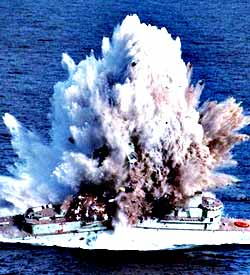Blast
Injuries
Blast injuries can be military or civilian
in origin. Blast injuries from bombs, missiles, hand grenades
and land mines are familiar to military physicians.
On home soil, though, blast injuries can
result from mining and industrial explosions, home gas leaks or
terrorist attacks. Medical personnel had to attend to many blast
injuries incurred by the victims in the Oklahoma City bombing
and the September 11 World Trade Center attack in New York.
Explosives themselves fall under the category of either high-order
explosives (HE) or low-order explosives (LE). High-order explosives
deliver an overpowering supersonic shock or blast wave. Low-order
explosives create a subsonic blast lacking the intensity of the
HE's over-pressuring wave. Some examples of high-order explosives
are TNT, C-4, nitroglycerin, dynamite, ammonium nitrate and Semtex.
Low-order explosives include pipe bombs, gunpowder, gasoline-based
Molotov cocktails or aircraft used as guided missiles.
Blast injuries are usually divided into four main categories:
primary, secondary, tertiary and quaternary. A primary blast injury
is caused by the over-pressurization blast wave from the explosion.
Therefore, primary blast injuries are targeted to human gas-filled
tissue such as those in the lungs, gastrointestinal tract and
ear.
Secondary blast injuries result from flying objects, debris and
bomb fragments. Penetrating ballistic or blunt injuries can occur.
Many eye injuries take place that are not evident for weeks or
months to come.
Tertiary blast injuries are caused by high-energy explosions,
which send people flying through the air and striking other objects.
Some common tertiary blast injuries include fractures, traumatic
amputation, and open and closed brain injuries.
Quaternary blast injuries include all of the other explosion-related
injuries, illnesses, or diseases not due to primary, secondary,
or tertiary mechanisms. This category also includes exacerbation
or complications of existing conditions. Example injuries include
burn, crush, asthma, angina and Hyperglycemia.
Some medical practitioners separate out the HE from the LE injuries,
though, much overlap does exist. The Low-Order explosive injuries
are further characterized by lacking the effects of the over-pressurization
wave. The LE injuries include those from fragmentation, blast
wind (not wave) and thermal damage.
Of all of the blast injuries, the most common fatal injury after
survival is the lung blast injury. Signs of blast lung are usually
immediately present and include apnea, bradycardia, and hypotension.
Blast lung should be suspected for those suffering from dyspnea,
cough, hemoptysis, or chest pain following blast exposure. A "butterfly"
pattern on chest X-ray is characteristic for those with blast
lung. Chest X-rays should be given as soon as possible for those
who have suspected lung injuries.
Blast injuries can occur for both civilians and military personnel.
It is imperative that the medical community be well-trained in
order to combat the effects of blast-related injuries.
|


